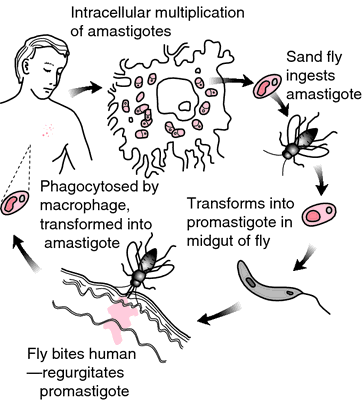Leishmania
[lēsh-ma´ne-ah]a genus of protozoa comprising parasites of worldwide distribution, several species of which are pathogenic for humans. All species are morphologically indistinguishable, and therefore the organisms have usually been assigned to species and subspecies according to their geographic origin, the clinical syndrome they produce, and their ecologic characteristics. They have also been separated based on their tendency to cause visceral, cutaneous, or mucocutaneous leishmaniasis. In some classifications, Leishmania is grouped in four complexes comprising species and subspecies: L. donovani, L. tropica, L. mexicana, and L. viannia.

Life cycle of Leishmania. From Mahon and Manuselis, 2000.
Leishmania brazilien´sis Leishmania viannia.
Leishmania donova´ni donova´ni a subspecies of the L. donovani complex causing the classic form of visceral leishmaniasis in India. It is transmitted by the sandfly Phlebotomus argentipes, with humans being the only major reservoir hosts. Called also L. donovani.
Leishmania ma´jor a species of the L. tropica complex, transmitted by Phlebotomus papatasi, causing the rural form of Old World cutaneous leishmaniasis. Called also L. tropica major.
Leishmania mexica´na a complex comprising the species and subspecies causing the New World form of cutaneous leishmaniasis in humans: L. m. mexicana, L. m. amazonensis, and L. pifanoi.
Leishmania tro´pica
1. a complex comprising the species causing the Old World form of cutaneous leishmaniasis: L. tropica, L. major, and L. aethiopica.
2. a species of the L. tropica complex causing the urban form of Old World cutaneous leishmaniasis. It is found in Iran, Iraq, and India, transmitted by Phlebotomus sergenti; and in southern France, Italy and certain Mediterranean islands, transmitted by P. papatasi. Human to human transmission may also occur.
Leishmania vian´nia a taxonomic complex comprising the subspecies that cause mucocutaneous leishmaniasis in its various forms; all of the subspecies develop in the midgut, foregut, and hindgut of their sandfly vectors. Formerly called L. braziliensis.
Miller-Keane Encyclopedia and Dictionary of Medicine, Nursing, and Allied Health, Seventh Edition. © 2003 by Saunders, an imprint of Elsevier, Inc. All rights reserved.
Leish·man·i·a bra·zil·i·en·'sis
a species that is the causal agent of mucocutaneous leishmaniasis, endemic in southern Mexico and Central and South America, and transmitted by various species of Lutzomyia (New World sandflies); forest rodents and other tropic arboreal animals serve as reservoir hosts. Leishmania braziliensis is currently divided into three clinically, epidemiologically, and biochemically distinct strains or subspecies: Leishmania b. braziliensis, Leishmania b. guyanensis, and Leishmania b. panamensis.
Farlex Partner Medical Dictionary © Farlex 2012